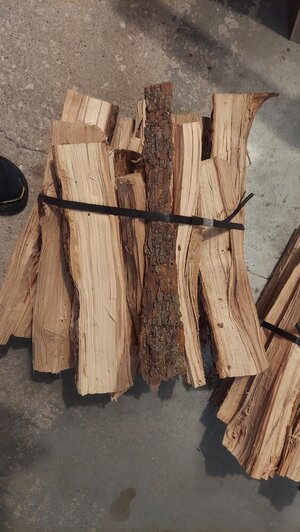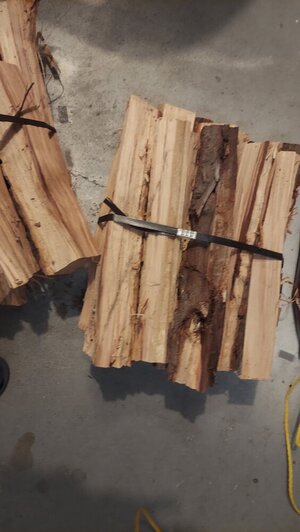Is there a difference between sapwood and heartwood. I bought some bundles of hickory, sugar maple, and one cherry, 5 bundles total. I noticed after having gotten them home that 80% of the wood was sapwood. I am new to smoking on a offset smoker or anything else for that matter. You may not be able to tell by the picture but most every piece is an outside piece with bark on it. I'm like I know a hickory tree is bigger than 10". I wonder what they did with the heart wood. Reminds me of watching a butcher cut up a side of beef on YouTube. Every time he squaring up thing for presentation his pile keeps getting bigger. I know I got to pay my dues, I guess he could smell the Similac (baby formula) on my breath. The Sugar Maple register 40% or better on my moister meter. The hickory and cherry is 18% or less. I expressly went there for the sugar maple.
Is there a difference between sapwood and heartwood
- Thread starter King Nud
- Start date
-
Some of the links on this forum allow SMF, at no cost to you, to earn a small commission when you click through and make a purchase. Let me know if you have any questions about this.
You are using an out of date browser. It may not display this or other websites correctly.
You should upgrade or use an alternative browser.
You should upgrade or use an alternative browser.
SmokingMeatForums.com is reader supported and as an Amazon Associate, we may earn commissions from qualifying purchases.
You will get different opinions on this topic. But here is my take on it...
Research has proven that the most flavor compounds for smoking in tree wood are found in the Cambrian layer just under the bark. Trade off is that when burning bark layers, you will create more creosote which for some people is the boogie man- but to get those flavor compounds you have to create a little creosote.. Chemically they are in the same family. The trick is to burn a clean fire with actual flame-not just smoldering..when the fire smolders you create too much creosote and it will affect the meat. I like to actually smell the smoke...if it smells acrid and bites or makes me cough-then I know it is creating too much creosote and not a clean burn; probably needs more oxygen so I open the bottom damper. If the smoke is thin, blue, and smells nutty, buttery, and light with no bite-that is the perfect smoke and I let it eat...come back and check in another 30 minutes....
Fire management is an art...learn the fire....smell the smoke...learn how to get that clean burn.
Research has proven that the most flavor compounds for smoking in tree wood are found in the Cambrian layer just under the bark. Trade off is that when burning bark layers, you will create more creosote which for some people is the boogie man- but to get those flavor compounds you have to create a little creosote.. Chemically they are in the same family. The trick is to burn a clean fire with actual flame-not just smoldering..when the fire smolders you create too much creosote and it will affect the meat. I like to actually smell the smoke...if it smells acrid and bites or makes me cough-then I know it is creating too much creosote and not a clean burn; probably needs more oxygen so I open the bottom damper. If the smoke is thin, blue, and smells nutty, buttery, and light with no bite-that is the perfect smoke and I let it eat...come back and check in another 30 minutes....
Fire management is an art...learn the fire....smell the smoke...learn how to get that clean burn.
Hijack73
Master of the Pit
Some folks peel/split off the bark. I tried it a few times but I'll be danged if I could tell the difference. The key on most smokers, like Inda is saying, is a small hot fire that's consuming the wood 'fairly' quickly.
Thanks for the feedback. I feel better about it.You will get different opinions on this topic. But here is my take on it...
Research has proven that the most flavor compounds for smoking in tree wood are found in the Cambrian layer just under the bark. Trade off is that when burning bark layers, you will create more creosote which for some people is the boogie man- but to get those flavor compounds you have to create a little creosote.. Chemically they are in the same family. The trick is to burn a clean fire with actual flame-not just smoldering..when the fire smolders you create too much creosote and it will affect the meat. I like to actually smell the smoke...if it smells acrid and bites or makes me cough-then I know it is creating too much creosote and not a clean burn; probably needs more oxygen so I open the bottom damper. If the smoke is thin, blue, and smells nutty, buttery, and light with no bite-that is the perfect smoke and I let it eat...come back and check in another 30 minutes....
Fire management is an art...learn the fire....smell the smoke...learn how to get that clean burn.
bill1
Master of the Pit
- Apr 25, 2015
- 1,963
- 926
I'll echo indaswamp...and point you to Blonder if you want a bit more science. But the heartwood is mostly cellulose, basically a sugar, so although it burns well as a fuel results in just carbon ash. The sapwood instead is rich in lignin, which is the source of the molecules with the good taste and smells.
I suspect the heartwood went to a wood-working friend whoo prefers heartwood for lumber...as he ought.
As somewhat of a confirmation of all this, I have had zero luck using lumber for smoking...just no flavor.
So I think you got what's best for your needs and someone else got what's good for theirs. And someone else got rid of a bunch of wood he didn't want. Win-Win-Win.
I suspect the heartwood went to a wood-working friend whoo prefers heartwood for lumber...as he ought.
As somewhat of a confirmation of all this, I have had zero luck using lumber for smoking...just no flavor.
So I think you got what's best for your needs and someone else got what's good for theirs. And someone else got rid of a bunch of wood he didn't want. Win-Win-Win.
Is there a difference between sapwood and heartwood. I bought some bundles of hickory, sugar maple, and one cherry, 5 bundles total. I noticed after having gotten them home that 80% of the wood was sapwood. I am new to smoking on a offset smoker or anything else for that matter. You may not be able to tell by the picture but most every piece is an outside piece with bark on it. I'm like I know a hickory tree is bigger than 10". I wonder what they did with the heart wood. Reminds me of watching a butcher cut up a side of beef on YouTube. Every time he squaring up thing for presentation his pile keeps getting bigger. I know I got to pay my dues, I guess he could smell the Similac (baby formula) on my breath. The Sugar Maple register 40% or better on my moister meter. The hickory and cherry is 18% or less. I expressly went there for the sugar maple.
A lot depends on if the trees were being trimmed, or if they were being cut down. Trimming gets mostly Sap wood, because a lot of it is from limbs. Cutting it down includes the inner main trunk, unless the logger is keeping the Heart wood for lumber, as that is the only part good for lumber.
I can tell you with experience that Carpenter Bees will drill tunnels & lay eggs in all kinds of sapwood, including hardwoods, but won't drill in Heartwood. They'll even drill Pressure Treated, but that's because they don't eat it.
And if all they are doing is "Air-Drying" there isn't much chance of getting it down much below 20% moisture content.
The Hardwoods I used to buy for my Cabinet shop was Kiln Dried to 6%, and then steamed back up to just under 8%.
Bear
MeatMaster19
Newbie
- Oct 27, 2022
- 11
- 3
Good to know. Thank you! I'm glad people are doing research on this stuff!You will get different opinions on this topic. But here is my take on it...
Research has proven that the most flavor compounds for smoking in tree wood are found in the Cambrian layer just under the bark. Trade off is that when burning bark layers, you will create more creosote which for some people is the boogie man- but to get those flavor compounds you have to create a little creosote.. Chemically they are in the same family. The trick is to burn a clean fire with actual flame-not just smoldering..when the fire smolders you create too much creosote and it will affect the meat. I like to actually smell the smoke...if it smells acrid and bites or makes me cough-then I know it is creating too much creosote and not a clean burn; probably needs more oxygen so I open the bottom damper. If the smoke is thin, blue, and smells nutty, buttery, and light with no bite-that is the perfect smoke and I let it eat...come back and check in another 30 minutes....
Fire management is an art...learn the fire....smell the smoke...learn how to get that clean burn.
SmokingMeatForums.com is reader supported and as an Amazon Associate, we may earn commissions from qualifying purchases.
Similar threads
- Replies
- 10
- Views
- 1K
- Replies
- 12
- Views
- 1K
- Replies
- 10
- Views
- 4K
- Replies
- 4
- Views
- 992
Hot Threads
-
Is anyone here in the automotive or truck sales business?
- Started by forktender
- Replies: 39
- General Discussion
-
Featured Prime Boneless Striploin Steaks on the Q
- Started by DRKsmoking
- Replies: 37
- Beef
-
Bucket list Smoker - Humphrey's Pint
- Started by dward51
- Replies: 22
- General Discussion
-
Your Favorite Way to Use Leftover Smoked Pork Ribs
- Started by Jim_C
- Replies: 21
- General Discussion







